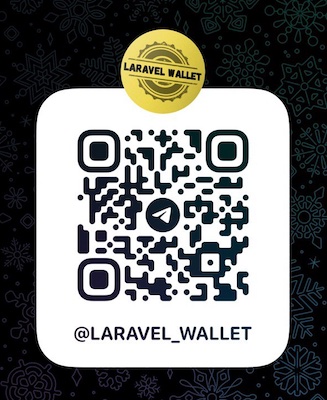laravel-wallet - Easy work with virtual wallet.
[Benchmark] [Documentation] [Get Started]
- Vendor: bavix
- Package: laravel-wallet
- Composer:
composer require bavix/laravel-wallet
| Version | Laravel | PHP | Release date | End of improvements | End of support |
|---|---|---|---|---|---|
| 7.x | ^6.0,^7.0,^8.0 | 7.4,8.0,8.1 | Nov 25, 2021 | Mar 1, 2022 | Sep 6, 2022 |
| 8.x | ^9.0 | 8.0,8.1 | Feb 8, 2022 | May 1, 2022 | Jun 1, 2022 |
| 9.x [LTS] | ^9.0,^10.0 | 8.0,8.1,8.2,8.3 | May 2, 2022 | Feb 1, 2023 | Feb 6, 2024 |
| 10.x [LTS] | ^10.0,^11.0 | 8.1,8.2,8.3 | Jul 8, 2023 | May 1, 2024 | Feb 4, 2025 |
| 11.x | ^11.0 | 8.2,8.3 | Mar 14, 2024 | May 1, 2025 | Sep 6, 2025 |
Important
If you are using laravel-wallet ^10.0 with laravel ^11, then the minimum php version is 8.2.
To perform the migration, you will be helped by the instruction.
I want to create a cozy place for developers using the wallet package. This will help you find bugs faster, get feedback and discuss ideas.
Telegram: @laravel_wallet
| Extension | Description |
|---|---|
| Swap | Addition to the laravel-wallet library for quick setting of exchange rates |
| uuid | Addition to laravel-wallet to support model uuid keys |
| Warm Up | Addition to the laravel-wallet library for refresh balance wallets |
Add the HasWallet trait and Wallet interface to model.
use Bavix\Wallet\Traits\HasWallet;
use Bavix\Wallet\Interfaces\Wallet;
class User extends Model implements Wallet
{
use HasWallet;
}Now we make transactions.
$user = User::first();
$user->balanceInt; // 0
$user->deposit(10);
$user->balance; // 10
$user->balanceInt; // int(10)
$user->withdraw(1);
$user->balance; // 9
$user->forceWithdraw(200, ['description' => 'payment of taxes']);
$user->balance; // -191Add the CanPay trait and Customer interface to your User model.
use Bavix\Wallet\Traits\CanPay;
use Bavix\Wallet\Interfaces\Customer;
class User extends Model implements Customer
{
use CanPay;
}Add the HasWallet trait and interface to Item model.
Starting from version 9.x there are two product interfaces:
- For an unlimited number of products (
ProductInterface); - For a limited number of products (
ProductLimitedInterface);
An example with an unlimited number of products:
use Bavix\Wallet\Traits\HasWallet;
use Bavix\Wallet\Interfaces\Customer;
use Bavix\Wallet\Interfaces\ProductInterface;
class Item extends Model implements ProductInterface
{
use HasWallet;
public function getAmountProduct(Customer $customer): int|string
{
return 100;
}
public function getMetaProduct(): ?array
{
return [
'title' => $this->title,
'description' => 'Purchase of Product #' . $this->id,
];
}
}Example with a limited number of products:
use Bavix\Wallet\Traits\HasWallet;
use Bavix\Wallet\Interfaces\Customer;
use Bavix\Wallet\Interfaces\ProductLimitedInterface;
class Item extends Model implements ProductLimitedInterface
{
use HasWallet;
public function canBuy(Customer $customer, int $quantity = 1, bool $force = false): bool
{
/**
* This is where you implement the constraint logic.
*
* If the service can be purchased once, then
* return !$customer->paid($this);
*/
return true;
}
public function getAmountProduct(Customer $customer): int|string
{
return 100;
}
public function getMetaProduct(): ?array
{
return [
'title' => $this->title,
'description' => 'Purchase of Product #' . $this->id,
];
}
}I do not recommend using the limited interface when working with a shopping cart.
If you are working with a shopping cart, then you should override the PurchaseServiceInterface interface.
With it, you can check the availability of all products with one request, there will be no N-queries in the database.
Proceed to purchase.
$user = User::first();
$user->balance; // 100
$item = Item::first();
$user->pay($item); // If you do not have enough money, throw an exception
var_dump($user->balance); // 0
if ($user->safePay($item)) {
// try to buy again
}
var_dump((bool)$user->paid($item)); // bool(true)
var_dump($user->refund($item)); // bool(true)
var_dump((bool)$user->paid($item)); // bool(false)// When working with one wallet
User::with('wallet');
// When using the multi-wallet functionality
User::with('wallets');Add the HasWalletFloat trait and WalletFloat interface to model.
use Bavix\Wallet\Traits\HasWalletFloat;
use Bavix\Wallet\Interfaces\WalletFloat;
use Bavix\Wallet\Interfaces\Wallet;
class User extends Model implements Wallet, WalletFloat
{
use HasWalletFloat;
}Now we make transactions.
$user = User::first();
$user->balance; // 100
$user->balanceFloat; // 1.00
$user->depositFloat(1.37);
$user->balance; // 237
$user->balanceFloat; // 2.37All versions:
| Name | 7.3 | 8.4 | 9.6 | 10.1 | 11.0 |
|---|---|---|---|---|---|
| Atomic:Blocks | - | - | 484ms | 493ms | 493ms |
| Cart:EagerLoaderPay | 22s | 679ms | 493ms | 530ms | 652ms |
| Cart:Pay | 1.36s | 472ms | 288ms | 298ms | 336ms |
| Cart:PayFree | 1.3s | 415ms | 281ms | 291ms | 287ms |
| Cart:PayOneItemXPieces | 565ms | 118ms | 59.1ms | 64.6ms | 66.2ms |
| Gift:Gift | 44.8ms | 53.5ms | 54.3ms | 58.4ms | 64.3ms |
| Gift:Refund | 106ms | 112ms | 108ms | 111ms | 139ms |
| Solo:Deposit | 27.4ms | 31.8ms | 31ms | 33.3ms | 30.1ms |
| Solo:EagerLoading | 904ms | 1.09s | 876ms | 927ms | 1.02s |
| Solo:ForceWithdraw | 27.6ms | 31.8ms | 30.7ms | 32.9ms | 30ms |
| Solo:GetBalance | 20.8ms | 24ms | 23.7ms | 23.4ms | 20ms |
| Solo:Transfer | 39.4ms | 45.7ms | 42ms | 44.9ms | 46.6ms |
| Solo:Withdraw | 31.1ms | 36.3ms | 34.9ms | 37.3ms | 37.8ms |
| State:InTransaction | 570ms | 566ms | 419ms | 425ms | 427ms |
| State:RefreshInTransaction | 32.3ms | 41.2ms | 41.2ms | 45.6ms | 47.2ms |
| State:TransactionRollback | 29.7ms | 34.1ms | 32.9ms | 37.2ms | 36.9ms |
Table generated using benchmark. Pull Request.
Supported by
This project exists thanks to all the people who contribute. [Contribute].
Become a financial contributor and help us sustain our community. [Contribute]
Support this project with your organization. Your logo will show up here with a link to your website. [Contribute]



